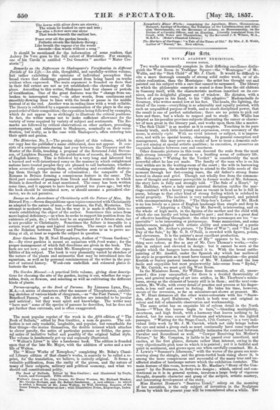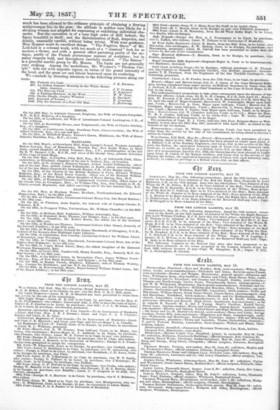/in Arts.
THE ROYAL ACADEMY EXHIBITION. FOIIRTIL NOTICE.
Two works uncommonly complete in their differing excellence distinguish the West Room in Trafalgar Square—the "Montaigne" of Mr. Wallis, and the "Sick Child" of Mr. J. Clark. It would be difficult to cite a more thorough example of strong solid entire work, or of absolute realization, than the Montaigne : the artist has thought out and painted out his subject with a care that cannot be surpassed. The library in which the philosophic essayist is seated is done from the old château in Gascony itself, with the characteristic mottoes inscribed on its cornices, and its delightful glimpse out of window. He dictates, with a bunch of grapes in his hand, to his "file adoptive" Mademoiselle de Gournay, who writes seated low at his feet. The luswls, the lighting, the detail of the room—everything is so admirably and equally painted, with such an unqualified purpose of truth, and so much disciplined power, that the result is one of perfect satisfaction ; there are no points to pick out here and there, but a whole to respect and to study. Mr. Wallis has adopted as his peculiar province subjects illustrating the career or character of men great in the literary past, and works upon them like a master. "The Sick Child" is as modest as it is complete. Touching in its pure homely truth, each little incident and expression, every accessory of the scene, is strictly right. With no vivid interest or subject, it is impressive, and with no special beauty, charming. In general conception and management, this may serve as a model of how to treat a domestic subject not aiming at special artistic qualities ; in execution, it preserves an exquisite balance between ease and exactness. Other domestic pictures in this room descend the scale from the most high-strung intensity of emotion to a bustling scene of ordinary life. Mr. Solomon's "Waiting for the Verdict" is considerably the most powerful effort he has yet made. The family of the man who is on his trial within are in the waiting-room of the court ; the wife in harrowing crushing suspense, the mother trying to attend to the little needs of the moment through her fast-coming tears, the old father's strong frame bowed in shame and grief. Though not wholly free from the commonness of thought and manner perceptible in former works of Mr. Solomon, the story here is fully and strongly told. "The Sale of a Heart," by Mr. Halliday, where a lady under paternal dictation ratifies the marriage-contract with a heavy young man as vacant in head as he is full in purse, belongs to that other kind of strong feeling which is subdued to social propriety. The incident is very naturally imagined, and painted with uncompromising fidelity. "The Ship-boy's Letter" of Mr. Hook is no less lovely as a piece of English landscape than simple and deep in sentiment. "Adopting a Child," by Mr. Barwell, is interesting, and on the whole of high merit, in the figures of the mother and the child with which she can hardly yet bring herself to part ; and there is a great deal of effective handling throughbut : the other two personages are too "respectable" to be interesting or picturesque. Some mannerism, and some imitativeness, mingled with artistic ability and something of a poetic touch, mark Mr. Archer's picture, "In Time of War "; and "The Last Day of the Sale," by Bir. G. B. O'Neill, is crowded with figures, points, and cleverness. It is the painter's most excellent production. "Canute Listening to the Monks of Ely" appears to be, in everything save colour, as fine as any of Mr. Cave 'Thomas's works,—valuable in subject and elevated in design : but it cannot be seen at the height which the hangers have doomed it to. With the broad cattlepainting of Mr. Ansdell, under the Spanish sky which has mellowed his style in proportion as it must have tanned his complexion—the genial Kentish or Surrey pastoral landscape of Mr. W. Linnell—and the less facile and enjoyable but most praiseworthy lake-scene from. " Hydal," by Mr. Carrick, we must quit thg West ROOM. In the Miniature Room, Sir William Ross remains, after all, unsurpassed; this year unequalled,—for there is a decided theatricality of pose, and general merging of art into artifice, in Mr. Thorburn's miniatures, strong as the element of beauty still is in them ; and the next competitor, Mr. Wells, with every detail of practice and process at his fingerends, is less naff and sweet in feeling. He bides his time, however, secure of the reversion, so far as miniature-art shows at present. Mr. A. W. Hunt distances all the other water-colourists with his "Snowdon, after an April Hailstorm," which is both true and original in colour and full of admirable observation and workmanship.
The same artist has an exquisite bit of sylvan detail in the North Room—" When the leaves begin to turn,"—blending multiplicity, sweetness, and high finish, -with a harmony that leaves nothing to be desired, but for some excess of blueness and whiteness in the lighted passages. "Waiting for the Stage-Coach, 17th Century," is a very individual little work by Mr. J. M. Carrick, which not only brings before the eye and mind a group such as must continually have come together under the circumstances, but thoughtfully intimates the contrast between Cavalier and Roundhead as well. "Cowper Receiving his Mother's Picture," by Mr. Compton, is liable to be passed over unnoticed, and excites, at the first glance, distaste rather than interest, owing to the very objectionable pink tone in which it is painted ; yet it is faithful and quiet in sentiment, and grows upon one when carefully examined. Mr. A. J. Lewis's " Summef s Afternoon," with the waves of the green sea murmuring along the shingle, and the green-turfed bank rising above it, is among the more conspicuous and successful of the many true and unaffected studies of landscape nature which the exhibition contains. The main feature of this room, however, is Mr. Maelise's " Story of the Conquest" by the Normans, in forty-two designs ; which, unreal and conventional as it is in general system, involves a large body of vigorous thought, dramatic character and grasp of the subject, artistic mastery, and interesting development of the story.
Miss Harriet Homer's "Beatrice Cenci," asleep on the morning of her execution, is the only subject of invention in the Sculpture Room by which the present year will be remembered after a while. Too much has been allowed to the ordinary principle of obtaining a flowing sculpturesque line in the pose : the attitude is neither very likely for a sleeping woman nor adapted for expressing or exhibiting individual character. But the execution is of a very high order of skill indeed ; the figure beautiful in itself; and the discrimination of flesh, draperies, and details, unusually careful, without being trivial. With wise guidance,
Miss Hosmer must do excellent things. The Fugitive Slave of Mr. Leifchild is a colossal work with too much of a "classical" look for so modern a theme, and with a general effect partaking partly of the antique, partly of the French picturesque manner of sculpture ; but in many respects bold, and throughout carefully studied. "The Sisters" is a graceful marble group by Mr. Munro. The busts are not generally very striking. Among the medallions, Mr. Woohaer's "Thomas Carlyle" tells out with majestic vigour, in virtue of the grand intensity of the head, and the great art and labour bestowed upon its rendering.
We conclude by directing attention to the following pictures along our route.
480. Portrait of a Lady It. Parsons. 497. An Indian Summer Morning in the White Moun tains, America J. F. Cropsey. 514. The Harvest Field B. .Redgrare. 588. A Fishing-Harbour, in the West W. W. Fenn. 1005. On the Dargle, County Wicklow .R. Borchelt. 1021. Souvenir of Scutari E. Armitage. 1040. Pity the Sorrows of a Poor Old Man .L. Hollotray.



























 Previous page
Previous page